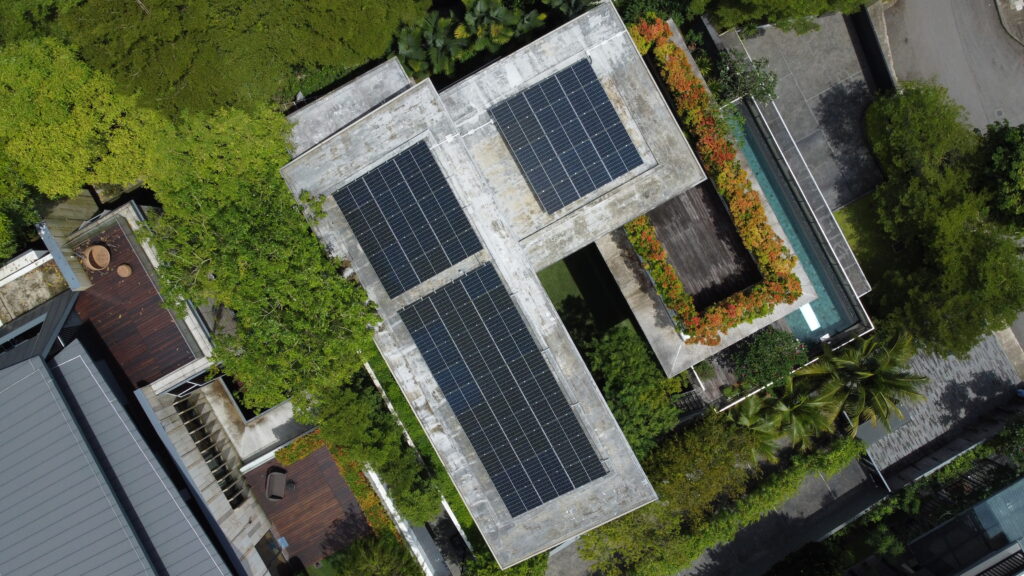1. Output and Efficiency
The most important factor when choosing solar panels is output and efficiency. Like the Vertex S DE09R.08 solar panel shown in the picture below, all solar panels have a power output denoted by a “W”, or watts, and can exist as a range or a precise value. Watts signifies the electricity generation capacity of the solar panel within 1 solar hour (will be explained later). The higher the wattage of a solar panel, the more electricity it can produce.
In some instances, the solar panel’s output is denoted as watts peak (Wp). Wp represents the maximum power a panel can generate under ideal conditions, calculated by multiplying the panel’s maximum voltage and maximum current at standard test conditions (STC – 25 degrees Celsius, Airmass of 1.5 and solar irradiation of 1000W/M sq).

The process of counting solar panel output
Determining the electricity output of a solar panel system requires an understanding of peak sun hours. A peak sun hour is defined as an hour of sunlight that reaches an average of 1,000 watts of power per square meter. In layman’s terms, since sunlight is not constant throughout a day, peak hours are used to denote the number of maximum hours of sunlight a solar panel can get in a day, which on an average day is approximately 3.5 peak sun hours.
To calculate the daily energy production of your solar panel system, you simply multiply the power output of your solar panels by the number of sunlight hours.
Calculating the monthly power output of a solar panel system
To calculate the power output of a solar panel system in a month, we would require a few pieces of information:
- Number of solar panels in the system
- Power output of 1 solar panel
- Peak sun hours in a day
Now let us take a look at an example. A solar panel system has 20 solar panels and the power output of each solar panel in 1 peak sun hour is 430W. Given that peak sun hours in a day is approximately 3.5 hours, we would get a total output of 430W x 20 panels x 3.5 sunlight hours x 30 days, which is equal to 903,000 watt hours (Wh) per month or 903 kilowatt hours (kWh) per month.
Is a solar panel with higher wattage better than one with a lower wattage?
While it is true that a solar panel with a higher wattage inherently generates more electricity than a solar panel with lower wattage, the panel’s size also plays a pivotal role in calculating the power generation capacity of the entire solar panel system. A 600W solar panel might indeed outperform a 430W panel, but it could also be physically larger. Consequently, the roof’s accommodation capacity for a larger panel might be significantly restricted compared to the smaller 430W panels. Ultimately, the crux lies in the cumulative power output of the entire system.
In most cases pertaining to residential solar panel systems, installers use solar panels with relatively smaller dimensions to have better flexibility when fixing them onto roofs. Furthermore, it is important to bear in mind that this computation offers an estimation, assuming ideal conditions. Real-world variables like shading, panel orientation and temperature affect actual performance. Relying on guidance from solar professionals grants a more precise insight tailored to your specific circumstances. For a deeper dive, visit our website and explore the possibilities.
2. Type of Material
Traditionally, solar panels are made up of 3 main types of materials: monocrystalline, polycrystalline and thin-film. However, most panel manufacturers these days focus on producing monocrystalline panels because of their superior efficiency. Within the monocrystalline panels exists 3 main types: P-type, N-type, and Heterojunction technology (HJT) solar panels.
1. P-type (positive type) solar panels
P-type solar panels, short for “Positive-type,” are the most common type of monocrystalline panels in the industry. They are made using crystalline silicon with added elements like boron to create a surplus of “holes” or positive charge carriers. P-type panels are known for being the most cost-effective monocrystalline option because of their relative technological maturity and established manufacturing processes. P-type panels have good efficiency and are suitable for a wide range of applications, from residential rooftops to commercial installations. While they can experience light-induced degradation (LID) and sensitivity to shading, advancements in technology have improved these aspects. P-type panels are often recognized by their traditional appearance with visible grid lines on the front.
2. N-type (negative type) solar panels
N-type solar panels, or “Negative-type,” are a recent trend within monocrystalline solar panel technology. It employs a different doping approach by introducing elements like phosphorus to create an excess of free electrons, forming negative charge carriers. N-type panels offer advantages like better performance in high temperatures, lower sensitivity to LID and enhanced resistance to potential induced degradation (PID). They often incorporate advanced manufacturing techniques and can be found in high-performance systems. While N-type technology is developing, it holds promise for durability and efficiency improvements.
3. Heterojunction technology (HJT) solar panels
HJT solar panels are at the forefront of solar cell innovation. They combine amorphous silicon (a-Si) and crystalline silicon (c-Si) layers in a unique design. The amorphous layer reduces charge carrier recombination, while the crystalline layer efficiently absorbs sunlight. HJT panels achieve high efficiency by capturing a broad spectrum of solar wavelengths. They exhibit minimal LID and can perform well in various temperature ranges. HJT’s potential for dual-sided absorption and sleek appearance make them suitable for diverse applications, from residential installations to specialized systems. Nonetheless, they may offer an exceptional array of advantages, HJT solar panels may come at a relatively higher cost.
| Aspect | P-type Solar Panels | N-type Solar Panels | HJT Solar Panels |
|---|---|---|---|
| Efficiency | Good efficiency | Potentially higher efficiency | High efficiency |
| Manufacturing Costs | Relatively lower costs | Slightly higher costs | Moderate to potentially higher costs |
| Light-induced degradation (LID) | Moderate LID | Lower LID | Minimal LID |
| Durability | Generally durable | Durable | Generally durable |
| Technological Maturity | Well-established technology | Developing technology | Emerging technology |
| Applications | Common for residential and commercial | Often used in high-performance systems | High-performance systems and specialized use |
3. Panel Degradation Rate
Understanding how to choose solar panels involves recognizing the concept of solar panel degradation. This term refers to the gradual decline of a panel’s efficiency and power output over time due to various environmental and operational factors. Different solar panels exhibit varying degradation rates. Therefore, considering degradation enables accurate comparison of panels based on their long-term performance, efficiency, and overall value. The rate of degradation is often quantified by the panel’s annual degradation rate (ADR), typically ranging between 0.5% to 1% per year. To counter degradation and enhance the lifespan and performance of solar panels, regular maintenance, proper installation, and selecting reputable manufacturers are pivotal strategies.
4. Warranties
When learning how to choose solar panels, delving into their warranties is a vital step. Typically, solar panel manufacturers/installers offer two primary types of warranties: power output warranty and product warranty. Taking warranty coverage into account not only provides insights into the duration of protection but also ensures you’re well-informed about the extent of coverage you’ll have for your investment.
1. Power output warranty
Power output warranties cover cases when the degradation rate of your panel exceeds the manufacturer’s quoted number. Naturally, if a panel’s degradation rate is higher than what it should be, the power output of your system will fall below guaranteed levels over time. Industry norms commonly extend this protection for a period spanning 20 to 25 years. This warranty not only encompasses assessment testing but also addresses any potential costs associated with system adjustments or replacements.
2. Product warranty
Product warranties, on the other hand, are designed to safeguard against hardware anomalies, including issues like sunspots on solar panels or frame corrosion. Typically spanning 5 to 10 years as an industry benchmark, some forward-looking manufacturers extend this coverage up to an impressive 20 years. When scrutinizing solar panel options, prioritizing those with robust product warranties is paramount.
The Catch
While manufacturer warranties have certainly improved and become more competitive over the years, there is a catch — most do not cover components of the solar panel system outside the solar panels themselves. This implies that issues with components like wiring and inverters are not covered under the manufacturer’s warranty.
GetSolar’s warranties
GetSolar offers our customers an encompassing warranty that encompasses all elements of the solar panel system. In addition, for customers enrolled in our rent-to-own (RTO) plan whose energy production falls short of our guaranteed amount, we ensure peace of mind by refunding the full shortfall amount. This means that you can rest assured, knowing that your solar systems’ energy production is in capable hands.

5. Aesthetics
Similar to other consumer products, aesthetics also factor in when considering how to choose solar panels for many homeowners. Aesthetics include factors like color, surface pattern and frame design. Some panels feature a sleek all-black design that blends well with rooftops, like the panels shown below.

6. Cost and Value
The final factor in the evaluation of solar panels is how to choose solar panels based on their cost and value. While the notion might seem self-evident, buyers tend to focus only upfront expenses. However, this approach carries inherent flaws. While upfront costs certainly hold significance, they should be assessed in tandem with the broader, enduring advantages encompassing energy savings and potential incentives. For instance, while Panel A might have a lower upfront cost than Panel B, the latter’s higher efficiency could lead to superior savings throughout its operational lifespan. By taking into account both immediate investment and long-term gains, you can make a calculated choice that aligns your budget with your energy goals.
To get an instant estimate on how much a solar panel system will cost for your home, you can access our free solar simulator by clicking here.
GetSolar’s rent-to-own (RTO) plans
High upfront costs of your residential solar panel system troubling you? Solar AI’s rent-to-own (RTO) plans offer a solution worth considering! Our RTO plans eliminate or reduce the need for any upfront costs from clients. Instead, you’ll only make fixed monthly payments, while we install, maintain and service your solar panel system free of charge.
To learn more about Rent-to-Own solar, click here!

Final thoughts
In conclusion, comparing solar panels requires a careful examination of their efficiency, durability, cost, warranty and other key factors. By conducting thorough research, you can choose solar panels that align with your energy needs, budget, and environmental goals. Consulting with solar experts and installers can also provide valuable insights to help you make a well-rounded decision, ensuring you harness the power of the sun efficiently and effectively.




